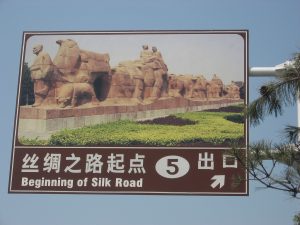One of the great merits of the New Silk Road concept, which played such a major part at the APEC meeting in Beijing, is that it is wonderfully vague in terms of the area talked about while being very specific in terms of the the national sentiments it appeals to back in China. The new use of this old term, pioneered by Xi Jinping, manages to create warm feelings outside China despite few really knowing what the Silk Road actually refers to. At the same time, talks of a New Silk Road stirs up equal enthusiasm domestically because it taps into memories of former greatness and its new iterations, placing China once more at the center of the world.
That the Silk Road idea is vague is not surprising, in view of its very amorphous roots. The historian Mark Edward Lewis, in his excellent history of the Tang Dynasty (618–907 AD), goes as far as referring not to a singular silk road, but to plural ones spreading out throughout land and maritime routes around the imperial dynasty. These silk roads, plural, created a zone of influence based on trade, most of it on terms favorable to the Tang court back in Xi’an. The grand sign that greets visitors to the ancient city today, pointing the way to the start of the Silk Road, is misleading, pointing more to a myth than a proper starting point. Like many other ancient trackways, the road was more a bandwidth or a combination of different lines.
This has carried across to the concept as it is set out today. Xi’s modern Silk Road seems to push itself through some of Southeast and South Asia, some of central Asia, and up into modern Russia. It also comes through the Middle East, and even nudges up to places like Lithuania and northern Europe. One could be forgiven for asking why the term is not jettisoned and replaced by the less mellifluous description “Eastern, Central and Western Asian landmass with a large part of Eastern Europe.”
The phrase “New Silk Road,” of course, is low on specifics in terms of where it reaches and what it is for the perfectly good reason that it is mapping out an ambition, an aspiration, not a specific geographical space. It is pointing to a world of mutually beneficial trade and economic relations focused on China. It is selling the merits of dealing with and working with China as a source of dynamic growth. Here we get to the domestic power of the image — it clearly trades off a notion of a China that was anciently strong and important, which is explicitly linked to the ambitions of the modern country, creating a coherent link across centuries.
Whether non-Chinese parties being embraced by the Silk Road idea are also signed up to this notion is another matter. They might be quite surprised to think that they are being pulled into something which has undertones of a vassal relationship, where China is posited almost as a gift-giver, generously granting access and links to its market and dispensing favor and economic largesse this way. There are obligations being created here, dependencies and commitments, that many who are included in the Silk Road idea might need to seriously consider. For Central Asian states, having a counter balance to Russia might be good, of course. For Russia, having a China which reduces European energy imports in importance for it is also useful. But the ambition outlined in all the train and road building is setting out the infrastructure of a commitment for decades into the future, not just a few years.
Silk Road partners might pay the Chinese the compliment of copying them. They too should seek diversity of partnerships, and not be backed into reliance on one overwhelming relationship. Ignoring the immense ambition of China now would be to run against a long history where it is pretty clear. This is perhaps the final link between the old and the new silk road ideas. They outline a world where whatever the number of different routes and tracks, they had one common characteristic — they all ended in China. That is a pretty powerful clue as to whose best interest is really being served by this new iteration of an old idea. This doesn’t mean other countries should not engage in the idea, but it does mean they should do so in a clear headed and realistic way.

































